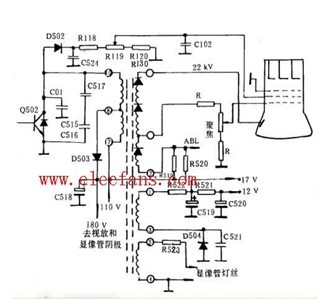The picture below shows the picture tube feeding circuit of Haiyan CS37-2 color TV. The filament voltage is supplied by the line flyback transformers 4, 5 windings via a current limiting resistor R523. The accelerating pole voltage is rectified by the D502 counter-reverse anti-peak pulse. After being filtered by C524, it is supplied by R118, R119, R120 and R130, and the high section R119 can adjust the voltage. The focus voltage and the anode high voltage are supplied by a multi-stage primary step-up winding, in which one-third of the taps are tapped, and the resistors are divided and supplied to the focus. The focus trimming resistor is also sealed in the transformer (the transformer uses the principle of electromagnetic induction to change the AC voltage. The main components are the primary coil, the secondary coil and the core. In electrical equipment and wireless circuits, it is often used as the lifting voltage, matching impedance, Safety isolation, etc.), only one handle is exposed. The focus voltage is directly led to the focus end of the tube socket by a high voltage lead and is well enclosed. The anode high voltage is supplied by all the high voltage windings, and is sucked by the high voltage lead with a round cap hooking sleeve at the high pressure nozzle of the tube cone. The electron beam current of the picture tube varies greatly with the content of the picture, so the high-voltage power supply adjustment characteristics are required. For this reason, some televisions are equipped with a high-voltage stable circuit.

Picture tube feed circuit diagram of Haiyan CS37-2 color TV
IDC D-sub Connectors
IDC (insulation displacement contact) D-sub connectors are a type of electrical connectorthat's designed to be connected to the conductor(s) of an insulated cable, most commonly a ribbon cable(a cable with many conducting wires running parallel to each other on the same flat plane).
Applications for IDC D-sub connectors
IDC D-sub connectors, attached to ribbon cables, are helpful in situations where you need to make a lot of connections without a big number of wires. They're commonly used in computer and electronic systems that require multiple data buses to link internal peripherals, such as disk drives to their drive controllers. They're also frequently used in industrial and telecom applications.
How does an IDC D-sub connector work?
With an IDC D-sub connector, there's no need for cable preparation – in other words, you don't need the strip the cables of their insulation before connecting. To connect the cable to the connector, there are sharpened blades (or contacts) on the connector that force through the insulation around the cable, making a secure connection.
IDC D sub connector from Antenk, Outstanding features high contact reliability, long life and low contact resistance.
Low Profile IDC D-Sub Connectors,Flat Cable IDC D-Sub Connectors,D Sub Connector IDC Type,IDC D-Sub Standard Connectors
ShenZhen Antenk Electronics Co,Ltd , https://www.antenk.com